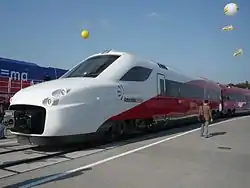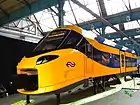NS International
NS International, formerly NS Hispeed, is the rail operator in the Netherlands that operates international inter-city and high-speed train connections to Belgium (Intercity Direct), France (Thalys), Germany and Switzerland (Intercity-Express).
.jpg.webp) One of NS International's ICE 3 trainsets operating between the Netherlands, Germany and Switzerland | |
| Main region(s) | Netherlands, Belgium and Germany]] |
|---|---|
| Other region(s) | France, Switzerland and United Kingdom |
| Parent company | Nederlandse Spoorwegen |
| Technical | |
| Length | 426 km (265 mi)[1] |
| Track length | Doesn't own any railway tracks. |
| Other | |
| Website | www |
NS International is part of the Nederlandse Spoorwegen. It currently operates both high-speed and non-high-speed services. Further international semi-high-speed and high-speed services are to be introduced in the near future.
History
NS Hispeed was formed in 2007 when the former international subdivision of NS, NS Internationaal, was rebranded as NS Hispeed. It is a founding member of the Railteam alliance, with a 10% share in the group. In June 2014, they changed their name to NS International. Trains running from Amsterdam to Brussels and Paris operate on the HSL-Zuid.
Services
Regional cross-border services (from Arnhem, Enschede, Hengelo, Maastricht, Nieuweschans, Venlo, Heerlen and Roosendaal) are not part of NS International, nor was the CityNightLine from Amsterdam to Munich and Zurich.
Rolling stock
NS International is the Dutch partner in three high-speed international services, Eurostar, Thalys and ICE International. Although the rolling stock for these services are pooled, each partner has purchased and owns a number of units in each fleet. NS owns three ICE 3M EMUs used for the ICE services, and two PBKA EMUs operated by Thalys, all of which are quadricurrent.
NS International ordered 16 V250 trains from AnsaldoBreda, with NMBS/SNCB ordering a further 3 sets. They were used on Dutch domestic services and NS International services to Brussels.[2] These sets are eight carriages long and have a top speed of 250 km/h. They entered service in December 2012 - five years later than originally planned.[3] They were taken out of service the following month due to numerous technical issues. Four months later only two of the 9 already delivered trains were still capable of performing test runs.[4]
| Class | Illustration | Type | Top speed | Number | Built | Notes | |
|---|---|---|---|---|---|---|---|
| mph | km/h | ||||||
| Series 43000 |  |
Electric multiple unit | 186 | 300 | 2 | 1997 | Used for Thalys service |
| DBAG Class 406 |  |
Electric multiple unit | 199 | 320 | 3 | 1999 | Used for ICE International service |
| V250 |  |
Electric multiple unit | 155 | 250 | 16 ordered | 2008-2010 | Trains were to be used for Fyra, but the order was cancelled in 2013 and the whole Fyra project abandoned |
| ICNG |  |
Electric multiple unit | 124 | 200 | 20 | 2019- | Intercity Nieuwe Generatie (New Generation Intercity)
A further 79 trainsets have been ordered, by the NS. Those will be used for service within the Netherlands |
References
- Amsterdam-Emmerich border, 115 km; high-speed line Schiphol-Antwerpen, 147 km; Amsterdam-Leiden-Rotterdam-Roosendaal, ? km; Amsterdam-Apeldoorn-Deventer-Almelo-Bad Bentheim border, 88+15+38+33 km.
- "Fyra brand for Amsterdam – Brussels high speed". Railway Gazette International. 2009-07-07. Archived from the original on 2012-04-14.
- "Fyra launch delayed again". Railway Gazette International. 2010-07-01. Retrieved 2010-07-02.
- "Bestemming beter Beslissing NMBS/SNCB over V250 - stellen" (PDF). NMBS. Retrieved 1 June 2013.